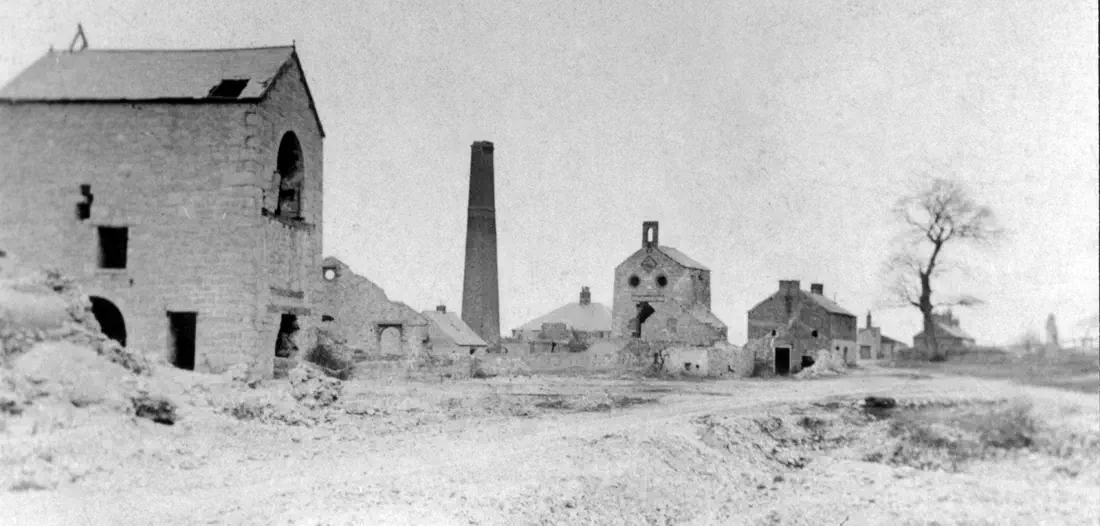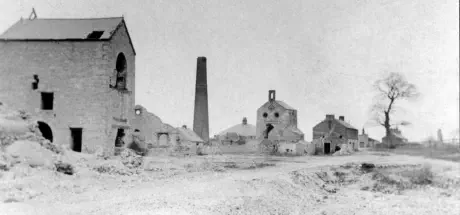
Talargoch

Talargoch about 1900. Looking north-east from near the 80” Engine Shaft.
To the left is the 80-inch Engine House.In the middle is the No.1 Engine House and its chimney,with the roof of the mine office visible between them.On the right
are the mine stables and Talargoch Cottages.
Above information (but not the photo) from Talargoch Mine by J.A. Thorburn

A brief summary of the mines at Talargoch
1303
First documentary evidence of mining in the area. Four German miners paid to search for copper ore (probably on Graig Fawr) but found only a small
quantity of lead.
1632
Apparently next record of mining. Mining rights of Carrog Ffaylon (now Graig Fawr) leased to Sir John Conway of Bodrhyddan Hall and Robert Davies for
7 years: “a work was sett up and payeth to the profitt of the miners many hundreds of pounds beside what Sir john gott”
1639
New partnership William Salesbury, Maurice Wynn and Richard Newell until 1646 when the Civil War caused a stoppage of the works.
1650
to
1660
Legal disputes over boundaries. 1660 to 1680 several short-lived leases and disputes over inheritance.
1681
Lands in Trecastell and Llewerllyd leased to Roger Whitley of Peel, Cheshire. He came to live at Dyserth Hall. Also reference to smelting mill at Desart
which appears to have been in Meliden Parish, but only worked spasmodically.
1705
Marriage of Elizabeth Whitley to the Earl of Plymouth.
1714
Lease of Dyserth mines to a partnership of Staffordshire men who probably introduced the first steam powered pumping engine into the area, but the
water problem seemed to be too great. The Governor & Company for smelting down lead with pittecoal and seacoale took the lease of the Talargoch site
to rework the surface tips for calamine.
1753
Paul Panton of Bagillt took lease of land between Dyserth and Talargoch for 21 years. At that time the mines all seemed to be in an abandoned state and
great expense was incurred in reopening the mines. Panton had leat built in the mid 1750s to take water from Afon Ffyddion above Dyserth waterfalls
along a course following the 200 feet contour line to the Talargoch site. This route of the leat caused much contention in later years. Panton acquired
leases to land along the Talargoch vein.
1763
Agreement between Panton and the partnership of Daniel Seaman and Thomas Smedley who held leases to the Bishop of St Asaph’s Talargoch property.
1769-1775 losses totalled some £3300 though output of ore slowly increasing. Losses continued.
1782
Charles Howard of Hawarden commissioned to build an engine, whimsey and waterwheel at the Engine Shaft.
1794
First dividend paid to partners.
1802
Accident when the headgear and waterwheels fell into shaft of the Great Engine Shaft.
1805
Cottages built for the miners at Meliden.
1830
About 200 people employed at the mines.
1840
School built for local children.
1845
Engine started at the new shaft (Clive Shaft). Engine had 50 inch cylinder with 10 ft stroke and constructed at John Taylor’s Rhydymwyn foundry. The
water for the engine was obtained via a new leat along the 300 feet contour from the Afon Ffyddion near Marion Mills. The leat was 16 ft wide at the top
and 9 ft at the bottom.
1851
350 men working at the Clive end of the workings, but only 34 at the Mostyn end owing to water problems.
1856
Strike closed the mine for 4 months.
1857
Talargoch Mining Company Ltd formed.
1861
Search for ore to the south east fruitless.
1862
New 100 inch cylinder engine installed at Clive Shaft.
Sinking of the Mostyn Shaft 1080 ft deep.
1870s
Talargoch mainly producing zinc ores rather than lead.
1874
Talargoch Mining Company in liquidation.
New company floated - The Old Talargoch Mining Company Ltd but did not attract enough investors.
1875
The Talargoch Mining Co Ltd formed. John Lean appointed as agent.
1883
Mine auctioned as going concern. Bought by Messrs Hughes and Lancaster of Acrefair, Wrexham.
1884
Underground working finished for good.
Strike to try and prevent removal of underground plant.
Break up sale.
1884
to
1905
Various small companies reworked spoil heaps.
I don’t know the original source of the above information. I am grateful to the late Mr Harry Parker for the loan of the documents.

Talargoch

Talargoch about 1900. Looking north-east from near the 80”
Engine Shaft.
To the left is the 80-inch Engine House.In the middle is the
No.1 Engine House and its chimney,with the roof of the mine
office visible between them.On the right are the mine stables
and Talargoch Cottages.
Above information (but not the photo) from Talargoch Mine
by J.A. Thorburn
A brief summary of the mines at Talargoch
1303
First documentary evidence of mining in the area. Four
German miners paid to search for copper ore (probably
on Graig Fawr) but found only a small quantity of lead.
1632
Apparently next record of mining. Mining rights of
Carrog Ffaylon (now Graig Fawr) leased to Sir John
Conway of Bodrhyddan Hall and Robert Davies for 7
years: “a work was sett up and payeth to the profitt of
the miners many hundreds of pounds beside what Sir
john gott”
1639
New partnership William Salesbury, Maurice Wynn and
Richard Newell until 1646 when the Civil War caused a
stoppage of the works.
1650
to
1660
Legal disputes over boundaries. 1660 to 1680 several
short-lived leases and disputes over inheritance.
1681
Lands in Trecastell and Llewerllyd leased to Roger
Whitley of Peel, Cheshire. He came to live at Dyserth
Hall. Also reference to smelting mill at Desart which
appears to have been in Meliden Parish, but only
worked spasmodically.
1705
Marriage of Elizabeth Whitley to the Earl of Plymouth.
1714
Lease of Dyserth mines to a partnership of Staffordshire
men who probably introduced the first steam powered
pumping engine into the area, but the water problem
seemed to be too great. The Governor & Company for
smelting down lead with pittecoal and seacoale took the
lease of the Talargoch site to rework the surface tips for
calamine.
1753
Paul Panton of Bagillt took lease of land between
Dyserth and Talargoch for 21 years. At that time the
mines all seemed to be in an abandoned state and
great expense was incurred in reopening the mines.
Panton had leat built in the mid 1750s to take water
from Afon Ffyddion above Dyserth waterfalls along a
course following the 200 feet contour line to the
Talargoch site. This route of the leat caused much
contention in later years. Panton acquired leases to land
along the Talargoch vein.
1763
Agreement between Panton and the partnership of
Daniel Seaman and Thomas Smedley who held leases
to the Bishop of St Asaph’s Talargoch property. 1769-
1775 losses totalled some £3300 though output of ore
slowly increasing. Losses continued.
1782
Charles Howard of Hawarden commissioned to build an
engine, whimsey and waterwheel at the Engine Shaft.
1794
First dividend paid to partners.
1802
Accident when the headgear and waterwheels fell into
shaft of the Great Engine Shaft.
1805
Cottages built for the miners at Meliden.
1830
About 200 people employed at the mines.
1840
School built for local children.
1845
Engine started at the new shaft (Clive Shaft). Engine
had 50 inch cylinder with 10 ft stroke and constructed
at John Taylor’s Rhydymwyn foundry. The water for the
engine was obtained via a new leat along the 300 feet
contour from the Afon Ffyddion near Marion Mills. The
leat was 16 ft wide at the top and 9 ft at the bottom.
1851
350 men working at the Clive end of the workings, but
only 34 at the Mostyn end owing to water problems.
1856
Strike closed the mine for 4 months.
1857
Talargoch Mining Company Ltd formed.
1861
Search for ore to the south east fruitless.
1862
New 100 inch cylinder engine installed at Clive Shaft.
Sinking of the Mostyn Shaft 1080 ft deep.
1870s
Talargoch mainly producing zinc ores rather than lead.
1874
Talargoch Mining Company in liquidation.
New company floated - The Old Talargoch Mining
Company Ltd but did not attract enough investors.
1875
The Talargoch Mining Co Ltd formed. John Lean
appointed as agent.
1883
Mine auctioned as going concern. Bought by Messrs
Hughes and Lancaster of Acrefair, Wrexham.
1884
Underground working finished for good.
Strike to try and prevent removal of underground plant.
Break up sale.
1884
to
1905
Various small companies reworked spoil heaps.
I don’t know the original source of the above information. I am
grateful to the late Mr Harry Parker for the loan of the
documents.



























































































































































